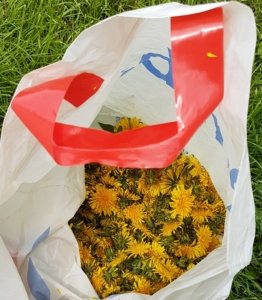This tastes a lot like honey, so is a brilliant substitute for vegans or anyone else avoiding honey. I prefer using the whole dandelion head. Not only is this quicker and easier, but I think the bitterness from the green parts of the dandelion adds to the complexity of the flavour of the finished honey.
Ingredients: to make 400-450ml
- 125g dandelion heads, stalks removed (about 200 dandelion heads).
- 2 thin slices of lemon.
- 500ml water.
- Approximately 450g granulated sugar.

I prefer muslin, or tote bags, but sometimes you’ve just got to use what you’ve got!
Method:
- Put the dandelions and lemon slices in a small saucepan and pour over the water. Bring the water to the boil and let it simmer gently for a couple of minutes.
- Remove from the heat, cover the pan and leave to steep for a couple of hours.
- Strain the liquid through a piece of muslin or a clean tea towel to remove the dandelion heads, give it a good squeeze to get every last drop of liquid out.
- Measure the liquid you have extracted. You should have about 450ml of liquid.
- Put the liquid into a large saucepan and add the same amount of sugar, so if you have 450ml of liquid add 450g granulated sugar.
- Warm the liquid and stir until all the sugar has dissolved.
- Bring it to the boil and boil the mixture for anything from 5-15 minutes, until it thickens.
- Test the honey frequently by taking a little bit on a spoon and putting it on a saucer or a plate, if is thickening even a little it is ready. It will still look very liquid in the pan, but it will thicken considerably as it cools.
Put the mixture into a warm sterilised jar, while it is still hot. Because of the high sugar content, the dandelion syrup will keep for at least 6 months but probably much longer.
For more information, a video and audio recording of the Wednesday Weed Waffle free zoom call we had about Dandelions, and an eBook with extra info and 3 recipes, have a look here: https://courses.foundfood.com/dandelion .
If you’d like to join the free zoom calls, the Wednesday Weed Waffle, register here: http://www.foundfood.com/zoom
To have a quick look at all the other recordings we have, look here: https://courses.foundfood.com/school




